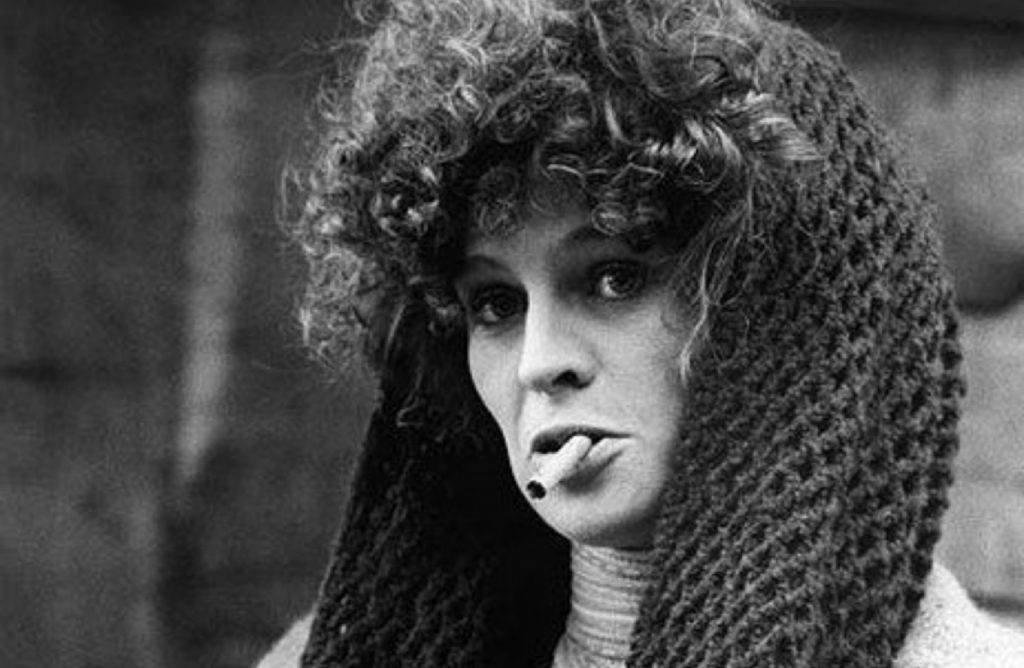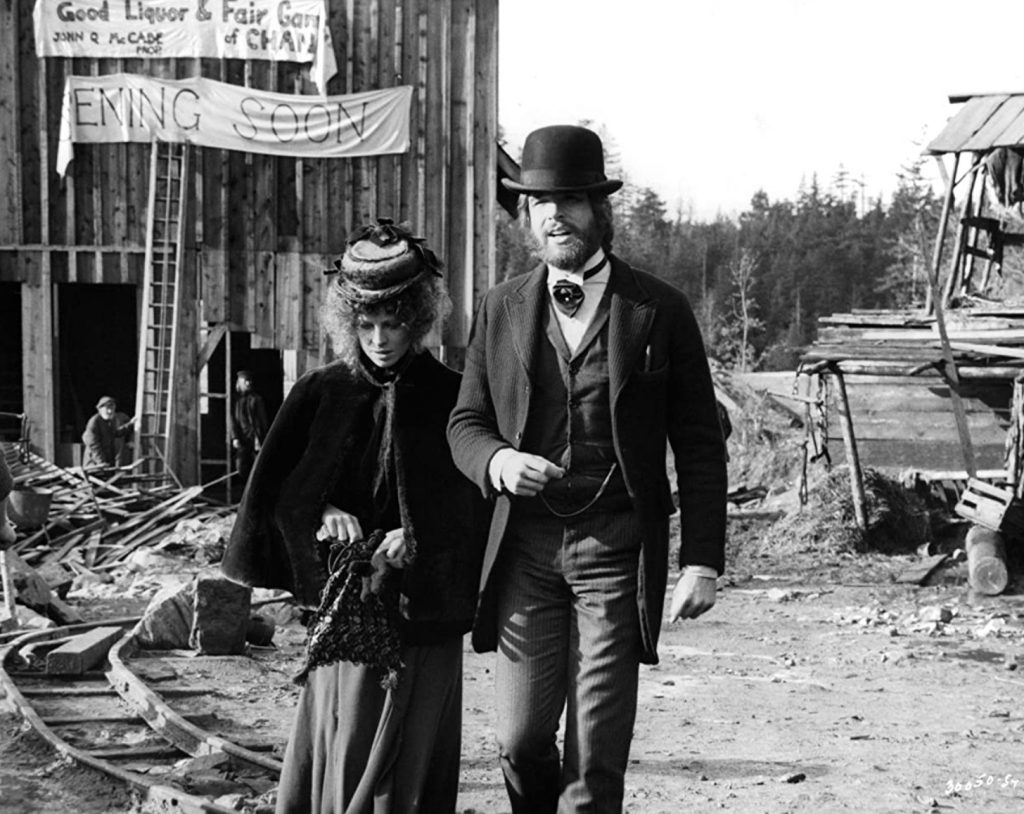Warren Beatty and Julie Christie in “McCabe and Mrs. Miller”. Warner Brothers
Robert Altman’s demystifying take on the Old West eschews the romanticism of the classic western. Yet McCabe and Mrs. Miller, at its 50th anniversary this year, has all the elements of the traditional Hollywood genre, but treated from a different angle, employing a style attuned towards naturalism and bearing a quality of intimacy to it, while conveying a microcosm of frontier life.
First, the haunting, bittersweet soundtrack of Leonard Cohen that pervades the film even when there is no music – “I had long discussions with Warren Beatty who wanted the soundtrack to be very distinct and I know it irritated a lot of people, but if I had put crystal clear sound like they did in the French version, then go see the film and tell me if it has kept any magic. I think that to criticise a part of a whole or to cut off a film from one of its elements, suddenly destroys it without even realising it,” Robert Altman told Bertrand Tavernier in an interview.
Then, the wild, snow-ridden, lurking with violence frontier town with its raw lumber and mud in the streets captured through the grainy, faded-out cinematography that gives the story such an authentic feel, leaving you with a pronounced sense of place, a vision of what frontier life might have been but that has never been told in this way before – “We approached McCabe like we had never seen a western and did a lot of research during that time. We discovered that in 1902 many things already existed that never appeared in most westerns.”
And those refreshingly flawed characters – McCabe is not a traditional hero, “which makes him closer to you and me,” Altman told Tavernier. “Anyway, we know everyone dies someday and McCabe has to think about it too. McCabe won his battle too, he killed his three guys, so why not say he won too? The fact that he then dies in the snow is a twist. I also see that he doesn’t die right away, like in a lot of westerns. Most of the deaths in the west were very slow and people took three days to die of gangrene because there was no medical treatment beforehand. You had to be hit in the heart or in the head to die instantly, which did not happen to the distance from where they fired and with the weapons they had.”
Warren Beatty and Julie Christie in “McCabe and Mrs. Miller”. Warner Brothers
Set in a northwest frontier town, the film has McCabe (Warren Beatty) as a gambler who opens up a brothel with Constance Miller (Julie Christie), a Cockney-accent, business-minded, opium-addicted prostitute. Their establishment thrives, mainly thanks to Mrs. Miller (who, from the very first meeting in the saloon, dominates the conversation), but soon the mining deposits in the town attract the attention of a big corporation which wants to buy everything out. McCabe refuses to sell, incapable of seeing the violent consequences of progress and capitalism, ending in a beautifully tragic tale of the American Dream.
Robert Altman used his protagonists’ star personas atypically, not as stars playing heroes, but by getting eloquent performances out of them as interesting characters, and by introducing the feeling of surprise further down the plot. Beginning the film with a stranger arriving in town “but using a star as Beatty saved me twenty minutes of narration. Seeing Beatty arrive on his horse, we know that he is an importaht character and that the film is about him. The public believes that McCabe is a hero since he is played by Beatty, the people of the city take him for a powerful man: it allows me later to create the feeling of surprise.”

Julie Christie in “McCabe and Mrs. Miller”. Warner Brothers
Mrs. Miller was a role that allowed Julie Christie to develop her craft as an actor. Christie came to the public’s attention in the British film Billy Liar (1959), in a role that caught the spirit that would characterise the 1960s and that had her incredibly well-received by the public, as a result of the image she projected on the screen. Then she rose to prominence after appearing in John Schlesinger’s Darling (1965) and David Lean’s Doctor Zhivago (1965), two films that were not only critical successes (she won an Oscar for Darling), but that further cemented her status as a cinema icon. Julie Christie constantly wrestled with that concentrated adulation, refusing to settle into one identity or another of her roles. Altman’s democratic style of filming and approach to character development allowed much freedom for the actors, encouraging them to write their own dialogue and improvise. “We didn’t have a clue what we were making because he [Altman] would get ideas overnight, or somebody would do a brilliant improvisation that just went on and on and he’s suddenly incorporate that,” Christie recalled.
The costumes were one other element that she contributed to shaping her character. Christie had to alter her physical appearance to play a 19th century whore in an American frontier town (the film was made in the British Columbia, Canada). Her blonde hair, luminous smile and romantic gaze gave way to a fizzy wig, coarse manners and a canny expression, a truly “indigenised” look rounded up by what was probably the result of Julie Christie’s and Alfreda Benge’s (reportedly Christie’s dresser, although Ilse Richter was credited for the wardrobe department) interpretations and reworking of existing clothes: a dark-brown velvet jacket (velvet was commonly used in the 19th century for dresses and jackets, only since the early 20th century having been considered a luxury fabric), ankle-length aubergine skirt, a carpet bag, a high neck blouse, a short fur cape, a black crocheted bag.
In the BFI booklet Julie Christie, Melanie Bell recounts how Altman asked the actors to put together their characters’ clothes from the production company’s stock costumes: “Now, you’ve got to live in these clothes in this fucking weather, so you’d better get out there and sew those holes up.” He gave free rein to everyone from leads to extras to choose their own outfits and encouraged them to customise their garments with “little artifacts” to make “their characters more real”. They had to care for their clothes and mend them just as real frontierspeople would have done a century before. The result is very authentic, for Mrs. Miller as well. Her clothes look lived in and are, quite frankly, one of the most authentic female costumes in westerns, which usually look so crisp and ”stylised” (even in female character-driven westerns, where women assume roles previously exclusively reserved to men, while men are a little more than mere objects of desire for the two), like they are part of a film, not part of real life, and this is what Altman’s film so brilliantly does differently. It is indeed a myriad of small details, from wardrobe to the dirt under the fingernails, that somehow play their part.
Constance Miller’s costume is so ingrained in the character that an overly analysis of the look would be besides the point. Because that look is just part of the landscape in a way, and part of the character – it was more than a performance, it was being present.

Warren Beatty and Julie Christie in “McCabe and Mrs. Miller”. Warner Brothers
Editorial sources: Amis américains: Entretiens avec les grands auteurs d’Hollywood, by Bertrand Tavernier; Julie Christie, by Melanie Bell
MORE STORIES
Time for tweed: Julie Christie in Don’t Look Now
The photographer who was as great as the stars he shot:
A conversation about Bob Willoughby
From the period authenticity of Meek’s Cutoff to the contemporary realism
of Boys Don’t Cry: In conversation with costume designer Vicki Farrell


